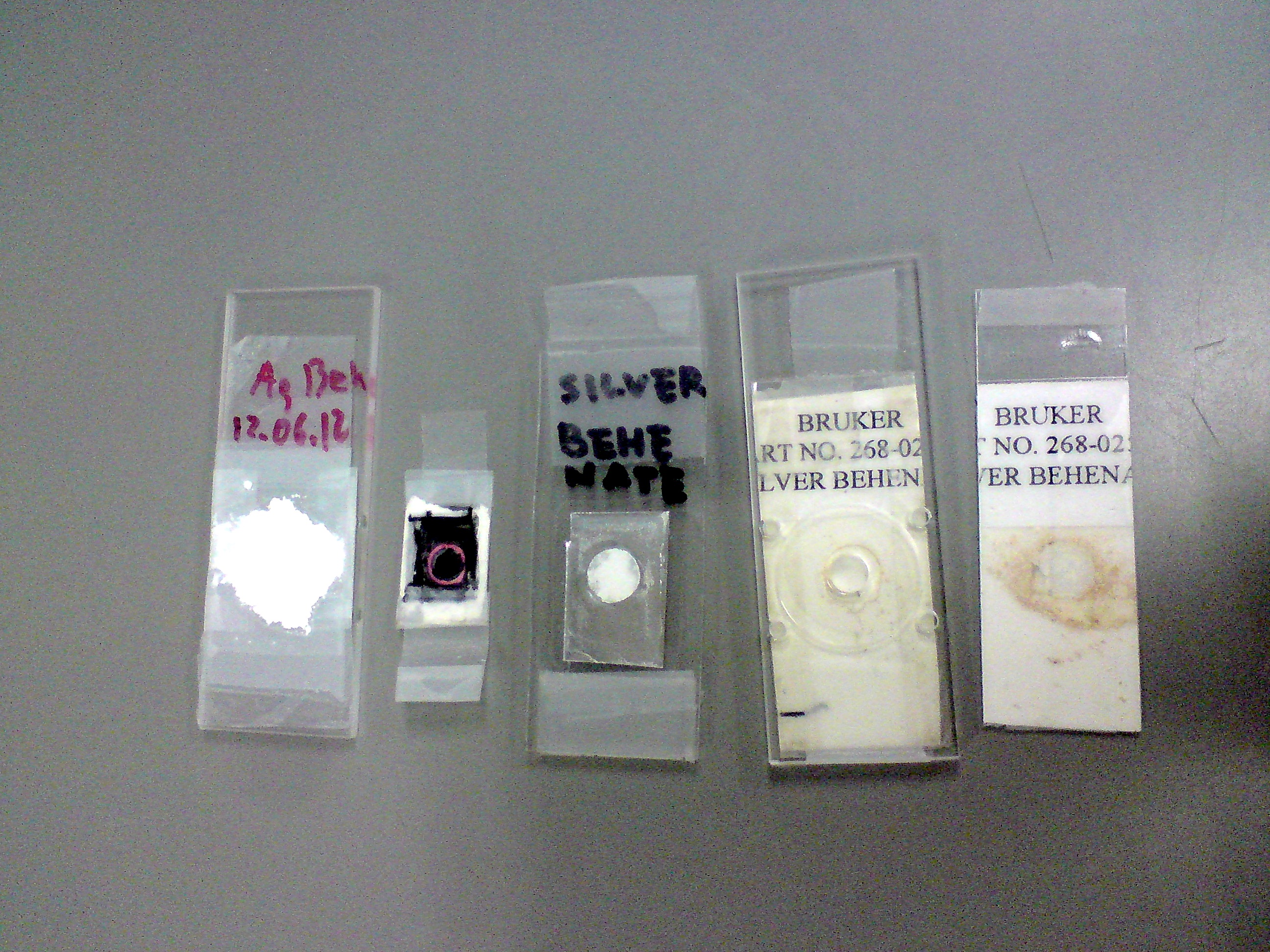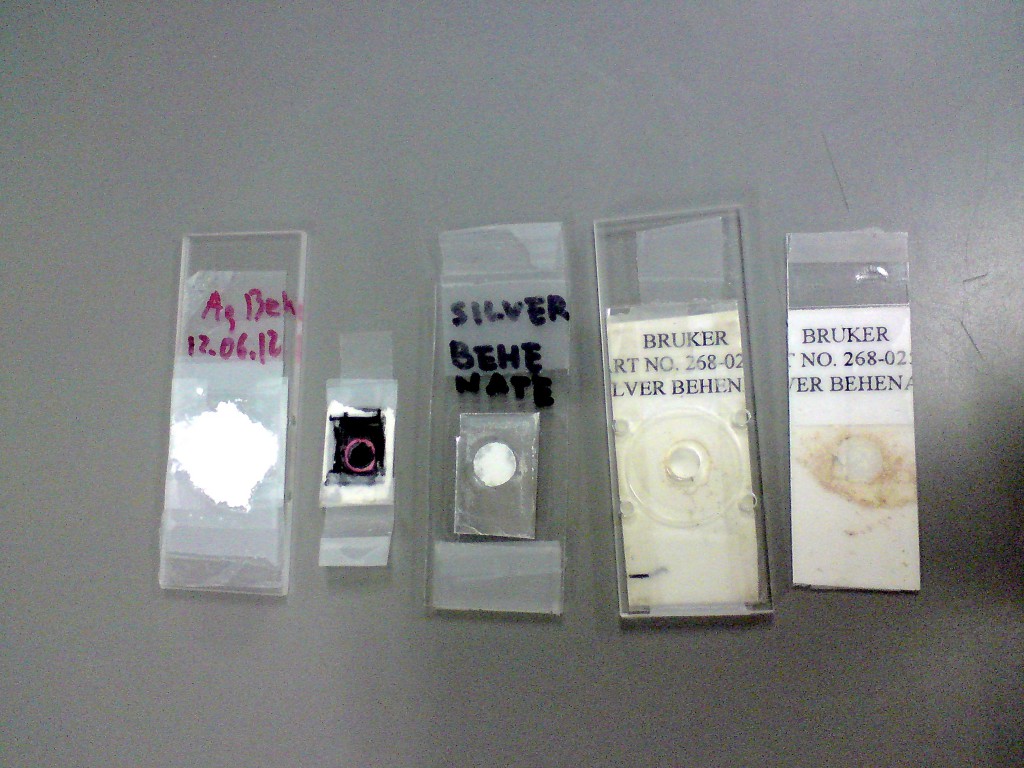
One of the most important parameters you need when analyzing small-angle scattering patterns is the distance from the sample to the detector, as this defines the scattering wave vector q. This is often determined using the same approach as for wide-angle diffraction: measurement of a standard crystalline sample. Whereas in the past, stretched rat tail collagen was l’objet du jour, these days people prefer the much more sensible silver behenate. This saves you from having to find a suitable rat donor, preparing the tail, and stretching it just so that it would give you the right answer (as the degree of stretching would affect the distance). Silver behenate is easier to apply, easy to get and shows a nice round crystalline peak for all but the smallest angles.
For a while now, though, I and some others have measured the sample-to-detector distance with a ruler when measuring. There are several benefits to this. Firstly, it is dead simple to do (there is no need to recode my diffraction ring-fitting method into Python, for example) and tools are readily available. Secondly, it is easy to calculate that even being off by a centimeter on the meter, the impact on the scattering vector q is minimal compared to the uncertainty in the measured intensity. Lastly, I do this because there is a rumor that silver behenate is in fact unstable, hygroscopic and essentially untrustworthy.

Now, though, it is time to put it to the test: Is there really so much variety in silver behenate? To test this, Pawel (one of my colleagues) collected all the silver behenate samples from the labs he could find (five, some of which indeed looked rather dubious), and we set about measuring and analyzing them using his standard method (300 seconds, after which the measurement was analyzed using Jan Ilavsky & co.’s excellent brainchild). Without further ado: these are the results from the measurements, the sample-to-detector distance in meters:
Sample A 1.3602
Sample B 1.3598
Sample C 1.3606
Sample D 1.3595
Sample E 1.3578
While this is hardly a comprehensive test, these results seem to indicate that silver behenate is about as accurate as a ruler, with a variance of a few millimeters to the meter. While I am not going to use silver behenate in my methodology just yet (I still haven’t programmed a ring fitting method in my new Python code, you see), I am now less likely to label silver behenate as unreliable.

Interesting indeed !
How about shorter distances (e.g. 30cm) ? The ruler method would still have the same “couple of mm” uncertainty, while silver behenate may be relatively better.
For shorter distances using a ruler gets more hairy and you are probably better off using LaB6 or another well-defined crystallographer’s sample like that. Unless, that is, you have a ruler built into your optical set-up (which I recommend anyway) in which case the ruler is accurate to maybe one millimeter provided you have at least some design drawings of the machine. If you are talking about a Kratky camera, kick your camera manufacturer into giving you the distance.
For shorter distances you also have to start worrying at some point about the sample thickness and a whole slew of other corrections that often do not apply to SAXS.
Performing the calculation of how much a minor variation in this distance would affect your scattering pattern wave vector is highly recommended, as it will show you that it really isn’t all that sensitive to this distance for small-angle purposes. You can, if you want, put 1% angle-axis error bars on the datapoints, but do consider that the binning or integration process may cover a wider range.
Thanks for your thoughts on this, Brian.
The other advantage of carelessly measuring silver behenate at each new experimental session is to get, in a single measurement, a way to assess the distance, the beam centre coordinates and the detector grid distorsion. That can come very handy for a posteriori checking. I think I get your point, though.
Hi Fred,
First of all, thanks for your interest.
As for the distortion map of the detector, you really need a measurement of a grid mask. There are quite a few distortions which are not accounted for by measuring a single diffraction ring (or even two). Incidentally, I gave up on trying to program the automatic grid mask pattern analysis and distortion correction for the time being, they are a little too complex for me (plus, having a Pilatus detector means we have no distortion). I could figure out where the points were, accounting for missing points as well, but I stopped there.
Beam center is nice to infer from rings, I use an image of the attenuated direct beam instead (but either will do fine). That way, I can also get an idea of the beam profile which can be used later for correction. I think, though, that the beam center does not really need to be more accurate than to the decimal pixel at most.